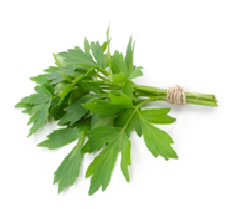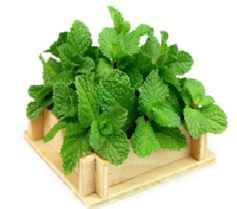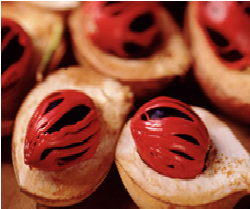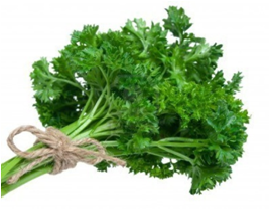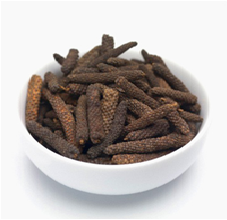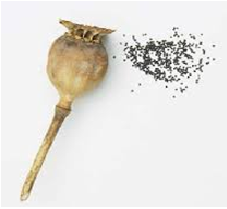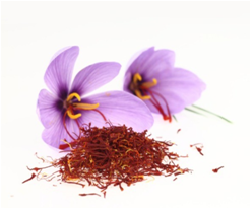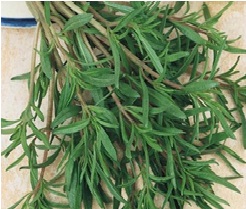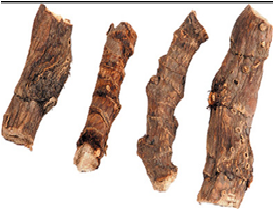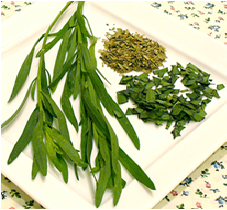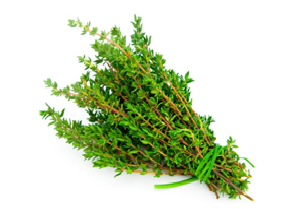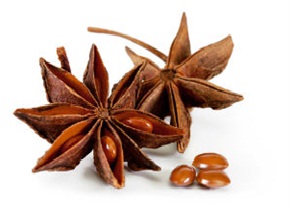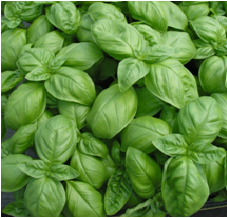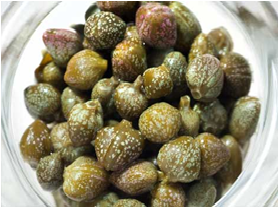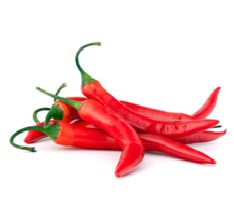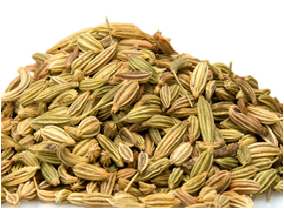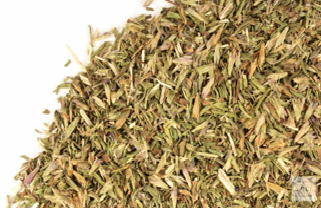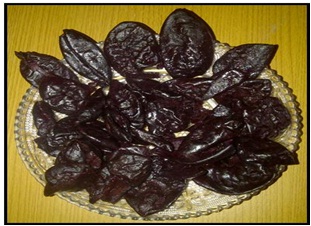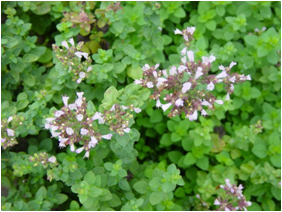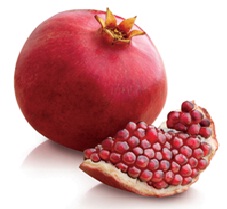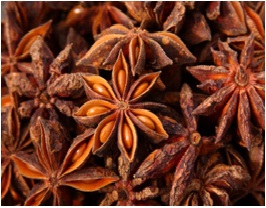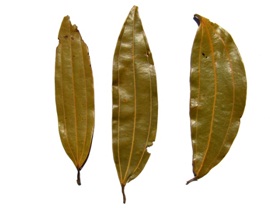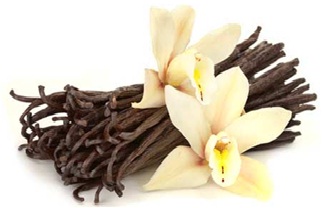Spices and Condiments in Indian Kitchens
- All spice
- Asafetida
- Bay leaf
- Cambodge
- Caraway
- Cardamom
- Celery
- Clove
- Cumin
- Dill
- Fenugreek
- Ginger
- Horseradish
- Juniper berry
- Lovage
- Mint
- Nutmeg
- Parsely
- Pepper long
- Poppy seed
- Saffron
- Savory
- Sweet flag
- Tarragon
- Thyme
- Aniseed
- Basil
- Bishop weed
- Caper
- Cinnamon
- Cassia
- Chilli
- Coriander
- Curry leaf
- Fennel
- Garlic
- Greater galanga
- Hyssop
- Kokam
- Marjoram
- Mustard
- Oregano
- Pepper
- Pomegranate
- Rosemary
- Sage
- Star anise
- Tamarind
- Tejpat
- Turmeric
- Vanilla
1. ALLSPICE [PIMENTO]
Allspice trees are evergreen medium sized, grow up to a height of 8 to 10 meters and with a slender upright trunk and smooth greyish bark. The mail trees produce only few fruits. The male and female trees are similar in appearance and cannot be identified till flowering commences.
Origin and Distribution:The tree is indigenous to West Indies (Jamaica) but is also found in Central America. Attempts to introduce into countries in tropical regions didn’t succeed fully. In India, there are few trees in Maharashtra, Tamil Nadu, Karnataka and Kerala. The dried berries range in size (6.5 to 9.5 mm in diameter) and there are 13 to 14 berries per gram. The quality of pimento is affected by factors like growing area, stage of maturity of berries at harvest to 70%) in domestic use (5% to 10%), production of berry oil (20% to 25%), extraction of oleoresin (1% to 2%) and pharmaceutical and perfume industry. Berry, berry oil, oleoresin, leaf oil are products of economic use. It is used mostly in Western cooking and less suitable for Eastern cooking. It has medicinal, antiand storage conditions.
Uses: The major use of allspice is in food industry (65 -microbial, insecticidal, nematicidal, anti-oxidant and deodorant properties.
| Botanical name | Family name | Commercial part |
| Pimenta dioica | Myrtaceae | Fruit & Seed |
Indian names : Kannada: Gandamenasu
2. Asafoetida
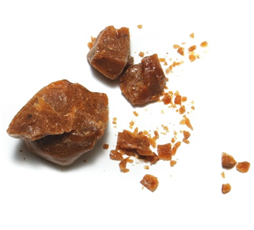
Asafoetida is the dried latex (gum oleoresin) exuded from the living underground rhizome or tap root of several species of Ferula (three of which grow in India), which is a perennial herb (1 to 1.5 mtr. High)
Origin & Distribution:The species are distributed from the Mediterranean region to Central Asia. In India it is grown in Kashmir and in some parts of Punjab. The major supply of asafoetida to India is from Afghanistan and Iran.
There are two main varieties of asafoetida ie. Hing Kabuli Sufaid (Milky white asafoetida) and Hing Lal (Red asafoetida). Asafoetida is acrid and bitter in taste and emits a strong disagreeable pungent odour due to the presence of sulphur compounds therein.
The white or pale variety is water soluble, whereas the dark or black variety is oil soluble.
Since pure asafoetida is not preferred due to its strong flavour, it is mixed with starch and gum and sold as compounded asafoetida mostly in bricket form. It is also available in free flowing (Powder form) or in tablet forms.
Uses: Asafoetida is extensively used for flavouring curries, sauces, and pickles. It is also used in medicines because of its antibiotic properties.
| Botanical name | Family name | Commercial part |
| Ferula asafetida | Apiaceae | Oleo gum resin extracted from rhizome and thickened root |
3. Bay Leaf
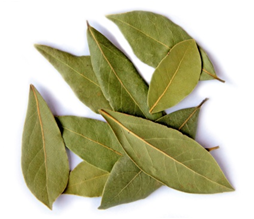
Bay Leaf or Laurel Leaf are dried leaves or an evergreen shrub or more rarely a tree attaining a height of 15 to 20 mtrs. The upper surface of the leaf is glabrous and shiny, olive green, and lower surface is dull olive to brown with a prominent rib and veins. The aroma of the crushed leaves is delicate & fragrant and taste is aromatic and bitter. The size of the leaves is ranging from 2.5 to 7.5 cms in length and 1.6 to 2.5 cms in breadth. The shape is elliptical and tapering to a point at the base and tip of the leaves.
Origin and Distribution : It is a native of Mediterranean and grow widely in scrub land woods in Europe and California. It widely cultivated in Europe, America and Arabian countries. It is not cultivated as a commercial crop in India.
Uses: Bay leaves are used as flavouring in soups, stews, meat, fish, sauces and in confectionaries. Both leaves and fruits possess aromatic, stimulant and narcotic properties. The essential oil from the leaves are also used as spice and food flavouring agent and has wider application in traditional medicines of different countries. The major functional properties are anti-microbial, anti-fungal, hypoglycaemic, anti-ulcerogenic etc.
| Botanical name | Family name | Commercial part |
| Laurus nobilis L. | Lauraceae | Leaf |
4. Cambodge
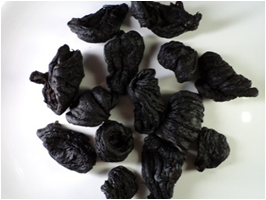
Cambodge is a tropical fruit commonly known as ‘Malabar Tamarind’ is a medium size evergreen dioecious tree with rounded crown and horizontal or drooping branches attaining a height of 18 mtrs. Fruit is a berry having a size of an apple, yellow or red, 6 to 8 grooves, forming blunt lobes with tough rind, 6 to 8 seeds and succulent arils. Fruit is weighing 50 to 180 gms.
Origin and Distribution: It is a native of Western Ghats of Kerala (India). Its habitat extends from Konkan southward to Travancore and into the shola forests of Nilgiris. It is fairly common in Sri Lanka and Malaysia.
Uses: The dried rind is used as a condiment for flavouring curries. In Sri Lanka the dried rind with salt is used for curing fish. The rind contains hydroxy citric acid and is widely employed in anti-obesity drugs.
| Botanical name | Family name | Commercial part |
| Garcinia cambogia | Clusiaceae | Pericarp-lobes |
Indian name: Kannada: Punrpuli
5. Caraway Seed
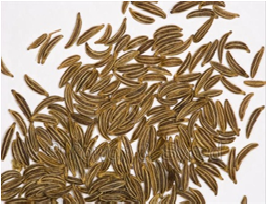
Caraway of commerce is the fruit of a biennial herb. The plant has a fleshy root and slender branched stem that attains a height of 0.5 to 0.6 mtrs, with small white flowers in compound umbels. The fruit when ripened splits into narrow elongated carpel, 4 to 6.5mm long, curved, pointed at ends with 5 longitudinal ridges on the surface. The dried fruit is brown in colour has pleasant odour is with sharp taste. Seeds are hard and sharp to touch.
Origin and Distribution: It is a native of North and Central Europe and is extensively cultivated in Holland, Russia, Poland, Bulgaria, Denmark, Rumania, Syria, Morocco, and to a small extent in England, and US. It is cultivated as a cold season crop in the hills of Kashmir and Kumaon at an altitude of above 2750 MSL.
Uses: Caraway is widely used as a spice for culinary purposes and for flavouring bread, biscuits, cakes and cheese. It is also used for seasoning sausages and as medicine.
| Botanical name | Family name | Commercial part |
| Carum carvi | Apiaceae | Fruit |
6.Cardamom
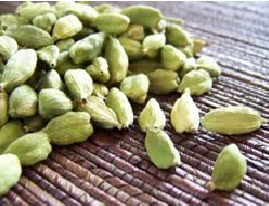
Cardamom of commerce is the dried ripe fruit (capsules of cardamom plant) often referred as the “Queen of Spices” because of its very pleasant aroma and taste. Cardamom is a perennial, herbaceous, rhizomatous plant. Based on the nature of panicles, three varieties are recognized viz. Malabar with prostrate panicle, Mysore with erect panicle, and Vazhukka with semi erect panicle. Plants are of medium size (2 to 3 mtr height) with pubescent leaves (on the dorsal side) and fruits globose in the case of Malabar, whereas plant robust (3 to 4 mtr height) with leaves glabrous on both sides with ovoid capsules in the case of Mysore. Vazhukka variety is a mix of both the above in physical characteristics.
Indian cardamom is offered to the international markets in different grades: ‘Alleppey Green Extra Bold’ (AGEB), ‘Alleppey Green Bold’ (AGB) and ‘Alleppey Green Superior’ (AGS) are names that register instant appeal worldwide. Cardamom oil is a precious ingredient in food preparations, perfumery, health foods medicines and beverages. India, a traditional exporter of cardamom to the Middle East countries where it goes mostly into the preparation of ‘Gahwa’ – a strong cardamom – coffee concoction without which no day is complete or no hospitality hearty for an Arab. Indian cardamom enjoys a premium preference in the Middle East, Japanese and Russians who relish it for its distinct enriching properties.
Origin and Distribution: Cultivation of cardamom is mostly concentrated in the ever green forests of Western Ghats in South India. Besides India, cardamom is grown as a commercial crop in Guatemala and on small scale in Tanzania, Sri Lanka, El Salvador, Vietnam, Laos, Thailand, Cambodia, Honduras, and Papua & New Guinea. The optimum altitudinal range on growing cardamom is 600 to 1500 mtr above MsL. The cardamom growing regions of South India lies within 8 – 30 degree N latitudes and 75-78 degree longitudes.
Uses: The major use is for the preparation of ‘gahwa’ – a strong cardamom coffee concoction which is a symbol for hospitality among Arabs. Apart from this cardamom is widely used as a flavouring material in whole and ground form. In Asia, it can add a lingering sparkle to every kind of dishes both traditional and modern. In Scandinavian countries it is used in baked goods and confectionaries. In Europe and North America it is an ingredient in curry powder and in some sausages products.
Cardamom oil and oleoresin has applications in flavouring processed foods, cordials, and liquors and in perfumery and in Ayurvedic medicines.
| Botanical name | Family name | Commercial part |
| Elettaria cardamomum Maton | Zingiberaceae | Fruit (Capsule) |
Indian name: Elaachi, Elakki
7. Celery
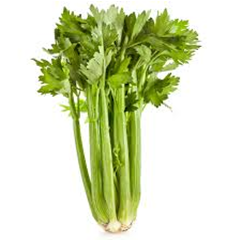
Celery is an umbelliferous, aromatic, herbaceous plant grown for its leaves, seeds, oleoresin and essential oil. Celery plant is usually 30-60 cm high, erect with conspicuously jointed stems, bearing well-developed leaves on long expanded petioles. The rigid fruit is small, ovoid, 1 to 1.5mm long, 1 to 2mm in diameter, contains a small brown seed.
Origin and Distribution: The native habitat of celery extends from Sweden to Egypt, Algeria and Ethiopia and in Asia, India and China. It is an annual in the planes, whereas, biennial in cold climate and on hills.
Uses:The dried ripped fruits (celery fruit) are used as spice. Leaves and stalks are used as salads and in soups. It is also widely used in meat seasonings, in flavouring beverages, confectionaries, ice creams and baked goods. It is figured as a natural medicine in different cultures. In modern medicine, it is used as a stimulant and for treating Asthma and liver diseases.
| Botanical name | Family name | Commercial part |
| Apium graveolens L. | Apiaceae | Seeds |
8. Clove
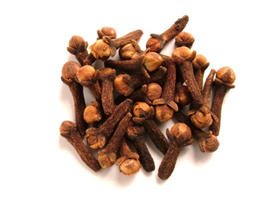
The clove of commerce is the air-dried unopened flower bud obtained from evergreen medium sized tree. The tree grows to a height of 10-12 mtrs and start flowering in about 7 years. It continues to produce flower buds for 80 or more years. It is a valuable spice of the orient. Clove clusters are plucked by hand when the buds are fully developed with a pronounced pink flush and then dried over several days in the sun. Unopened flower buds, leaves and stalks yield essential oil.
Origin and Distribution: The plant is indigenous to North Molucca Islands of Indonesia. It is also grown in Zanzibar, Madagascar, Malaysia, Sri Lanka and India. The tree prefers well drained rich soil with sufficient soil moisture throughout the year. High atmospheric temperature (25 to 35 degree C) with heavy sun light, good and well-distributed rainfall (above 150 cm) and high humidity (above 70%) are preferred.
Uses: The use of clove in whole or ground form is mainly for culinary purposes and as a flavouring agent in food industry. Its flavour blends well with both sweet and savory dishes. It is highly valued in medicine as carminative, aromatic and stimulant. In Indonesia, the lion share of production is consumed in production of ‘kretek’ cigarettes.
The antiseptic and antibiotic properties of clove oil are used in medicine especially in dentistry, oral and pharyngeal treatments. It has wider applications in preparations of toothpaste and mouthwashes, soaps and perfumes. It is also reported to help diabetics in sugar assimilations.
| Botanical name | Family name | Commercial part |
| Syzygium aromaticum | Myrtaceae | Unopened flower bud |
9. Cumin

Cumin is the dried, white fruit with greyish brown colour of a small slender annual herb. The surface of the fruit has 5 primary ridges, alternatively has 4 less distinct secondary ridges bearing numerous short hairs. The plant is 15 to 50 cm high. The aromatic seed like fruit is elongated, ovoid, 3 to 6 mm long, slightly bitter and has a warm flavour. The flowers are white or rose coloured in small umbels.
Origin and Distribution: Cumin is indigenous to Northern Egypt, Syria, the Mediterranean region, Iran and India. It is also cultivated in Mexico, China, Sicily and Malta. Cumin is a tropical plant and is cultivated as a rabi crop in areas where atmospheric humidity during February-March is low.
Uses: Cumin seed have an aromatic odour and bitter taste. It is used as a condiment, and is an ingredient in curry powders, seasonings of breads, cakes and cheese. It is employed in native dishes of Central and South America. In medicine, it is used as a stimulant, carminative, stomachic and astringent. Cumin seed oil is used in perfumery and for flavouring liqueurs and cordials.
| Botanical name | Family name | Commercial part |
| Cuminum cyminum L. | Apiaceae | Fruit |
Indian name: Jeera, jeerige
10. Dill
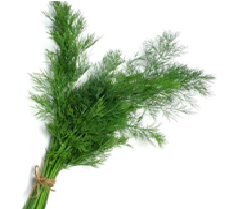
Dill is a herbaceous annual with pinnately divided leaves. The ripe, light brown seeds emit an aromatic odour. The leaves have pleasant aromatic odour and warm taste. Both seeds and leaves are valued as spice.
Origin and Distribution: European Dill (Anetheum graveolens) is indigenous to Europe and is cultivated in England, Germany, Romania, Turkey, USA and Russia. The Indian dill (Anetheum sowa), a native of Northern India is bolder than the European dill. It is cultivated as a cold weather crop in many parts of India.
Uses: Dill seed is used both whole and ground as a condiment in soups, salads, processed meats, sausages and pickling. Dill stems and blossom heads are used for dill pickles. The essential oil is used in the manufacture of soaps. Both seeds and oil are used in indigenous medicinal preparations. The emulsion of dill oil in water is an aromatic carminative.
| Botanical name | Family name | Commercial part |
| Anethum graveolens L | Apiaceae | Fruit |
Indian name: Kannada-Sabbasige soppu
11. Fenugreek

Fenugreek seed is the ripe fruit of an annual herb. This robust herb has light green leaves, is 30-60 cm tall and produces slender, beaked pods, 10-15 cm long, each pod contains 10-20 small hard yellowish brown seeds, which are smooth and oblong, about 3mm long, each grooved across one corner, giving them a hooked appearance.
Origin and Distribution: Fenugreek is a native of South Eastern Europe and West Asia, now cultivated in India, Argentina, Egypt and Mediterranean countries (Southern France, Morocco and Lebanon). In India it is grown extensively in Rajasthan, Gujarat, Madhya Pradesh, Uttar Pradesh, Maharashtra and Punjab.
It is a cold season crop and is fairly tolerant to frost and very low temperature. It is best suited to tracts of moderate to low rainfall and is sown in all types of soil but perform better in loam and clayey loam with proper drainage. It can also be grown on black cotton soils.
Uses: Fenugreek is used both as a food and food additive as well as in medicines. Fresh tender pods, leaves and shoots are eaten as curried vegetable. As a spice, it flavours food. Powder of dried leaves is also used for garnishing and flavouring variety of food. Fenugreek extract is used as a flavouring agent of imitation maple syrup. It is one of the principle constituent of curry powder.
The seeds are used in colic flatulence, dysentery, diarrhoea, dyspepsia, chronic cough and enlargement of liver and spleen, rickets, gout and diabetes. It is also used as a carminative, tonic, and aphrodisiac. Fenugreek oil is used in the manufacture of hair tonics.
| Botanical name | Family name | Commercial part |
| Trigonella foenum-graecum L | Fabaceae | Fruit |
12. Ginger
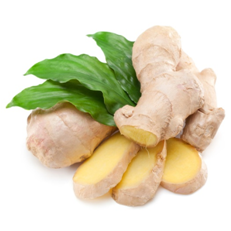
Ginger of commerce is the dried underground stem of the herbaceous tropical plant grown as an annual. The whole plant is refreshingly aromatic and the underground rhizome, raw or processed, is valued as spice. Ginger is a slender perennial herb, 30-50 cm tall with palmately branched rhizome bearing leafy shoots. The leafy shoot is a pseudo stem formed by leaf sheath and bears 8 to 12 distichous leaves.
Origin and Distribution: It is a tropical plant with the centre of origin in India and Malaysia. Now it is widely cultivated in India, Jamaica, Sierra Leone, Nigeria, Malaysia, Southern China and Japan.
Ginger requires warm and humid climate and thrives well from sea level to an altitude of 1500 mtrs above MSL. A well distributed rainfall (150 to 300cm) during growing season and dry spells during land preparation and harvesting are required for the crop. Though grows on a wide range of soils, lateritic loams are preferred for higher yields.
Uses: Fresh ginger, dry ginger powder, oleoresin and oil are used in food processing. It is indispensable in the manufacture of ginger bread, confectionary, ginger ale, curry powders, certain curried meats, table sauces, in pickling and in the manufacture of certain cordials, ginger cocktail, carbonate drinks, liquors etc.
In medicine, it is used as carminative and stimulant. It has wider applications in indigenous medicines. The ginger oil is used as food flavourant in soft drinks.
| Botanical name | Family name | Commercial part |
| Zingiber officinale Roscoe | Zingiberaceae | The rhizome |
13. Horseradish
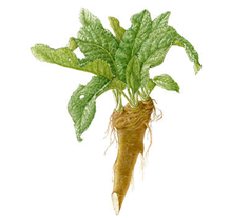
Horseradish is a hardy herb having large leaves, perennial and is grown for its pungent root, which contain oil with strong pungent odor and hot, biting taste. The plant attains a height of 0.6 to 0.9 mtr when in flower. Propagation is by planting pieces of side roots. The roots develop entirely underground and grow to a meter in length. The top of the plant consists of a rosette of large paddle-shape leaf and a flower stalk. It rarely produces seeds. White flowers with a sweet honey scent are produced on terminal panicles in late spring. There are two types of horseradish one is ‘common type’ with broad crinkled leaves and roots of high quality and the other is ‘bohemian type’ with narrow leaves and poor quality roots. The taproot is tuberous and cylindrical (30 cm long and 18 mm in diameter).
Origin and Distribution: Horseradish is a native of the marshy districts of Eastern Europe, Southern Russia and Eastern Ukraine but has become naturalized in North America and New Zealand. In India it is found growing to a small extent in gardens in North India and hill stations of South India.
Uses: Horseradish is used as an appetizing spice. The high Vitamin ‘C’ content present in it is credited with digestive and anti-scorbutic properties. Leaves are used in salads and sandwiches. Grated roots when mixed with vinegar and salt is an appetizing spice and a pungent condiment to enhance the flavour of boiled or roasted beef. Other products in use are horseradish cream, sauce, or relish. Horse raddish is available in dehydrated form also.
Horseradish is a stimulant, diaphoretic, diuretic, and digestive. It is used in the treatment for general debility, arthritis, gout, respirative infections, urinary infections and fevers.
| Botanical name | Family name | Commercial part |
| Armoracia rusticana | Brassicaceae | Rhizome |
14. Juniper Berry
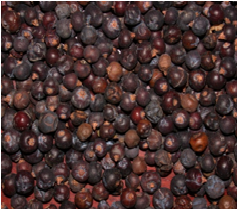
Juniper is an evergreen shrub sometimes attaining the height of a small tree up to 3 mtrs with erect trunk and spreading branches, covered with a shreddy bark. The trunk diameter is 25-30 cm. Leaves are straight and rigid, oval shape, about 6-13 mm long and with sharp prickly points. It is dioecious plant. The male and female flowers produced in April and May usually born on separate plants, the male flowers in short catkins and female flowers in small cones. The fleshy berry like fruit is sub-globose, bluish black, dark purple when ripe, 10-13 mm in diameter covered with waxy blook. The three scales comprising fruit, occasionally gaping and exposing bony seeds, usually three, elongated, ovoid, and embedded in the pulp.
Origin and Distribution : The plant grows wild in many parts of Europe and Asia and in North America. In India, it is found in Himalayas at an altitude of 1500-4000 mtrs above MSL. It thrives well on warm sunny places especially in mountain slopes.
Uses: The fruits are used as a food flavourant and as a food. In Europe it is used for the preparation of alcoholic beverages. Juniper oil is used in flavouring liquors and cordial. The fruits and volatile oil possess carminative, stimulant and diuretic properties.
| Botanical name | Family name | Commercial part |
| Juniperus communis | Cupressaceae | Berry |
Indian Names : Hindi- Aaraar : Sanskrit- Hapusha
15. Lovage
Lovage is a hardy perennial with a height of 90 cm, flowers in summer, dying down in autumn. It bears clusters of yellow flowers with a sharp smell. The roots are dug out in second or third year of planting and cut into slices in 13 mm thick and carefully dried.
Origin and Distribution: It is a native of Europe and is now cultivated in USA. In India it is grown in Nilgiris, Tamil Nadu. It grows well in well-drained soil. The seeds are sown in late summer and transplanted in the following spring.
Uses:The roots, seeds and leaves are used for flavouring foods. Flowering tops yield volatile oil. The leaves and stems are blanched and eaten as salads. In medicine it is used as a liver tonic and is used against bladder inflammation.
| Botanical name | Family name | Commercial part |
| Levisticum officinale | Apiaceae | leaf |
Name in international languages : English- Love Parsley, Lovage
16. Mint
Japanese Mint (Mentha arvensis) is a perennial herb with creeping root stalk and an erect stem, 1-2 quadrangulate branched with short dense hair. Leaves are 2.5 – 5cm long, oblong-ovate. Flowers are in auxiliary whorls, none at the top. Plant rises to a height of 0.4-0.8 mtr. Branching freely, flowers appearing in May-June and again in September-November under cultivation. Pepper Mint (Mentha piperita), Bergamot Mint (Mentha citrata) and Spear Mint (Mentha Spicata) are also commercially cultivated though on a lesser scale. These species are morphologically variant to that of Japanese Mint.
Origin and Distribution:These aromatic perennial herbs are distributed mostly in the Northern hemisphere. In India, it is largely confined to North India in the States of Uttar Pradesh, Punjab and Haryana.Temperate to tropical climate is suited for plant growth. Sunny weather with moderate rain is conducive to its luxuriant growth. A deep soil, rich in humus which can retain moisture, is suitable for mint cultivation.
Uses: Mint is used for flavoring meat, fish, sauces, soups, stews, vinegar, tea, tobacco and cordials. The mint oil is used for the production of natural menthol, dementhalised oil is for flavouring mouth washes, tooth paste and pharmaceutical preparations.
In medicine, it is used against stomach disorders, rheumatism, in ointments for headaches, in cough drops, inhalations etc. The oil and dried plants are antiseptic, carminative, refrigerant, stimulant and diuretic..
| Botanical name | Family name | Commercial part |
| Mentha piperita | Lamiaceae | Leaf |
Indian Names: Hindi- Pudina
17. Nutmeg & Mace
Nutmeg & Mace are two distinctly different spices produced from a fruit of an evergreen tree usually 9-12 mtr high. Mace is the dried reticulated ‘aril’ of the fruit and nutmeg is the dried seed kernel of the fruit. The trees are normally unisexual, bearing either male or female flowers. The male flowers are born in clusters, whereas female flowers are often solitary. Fruit is a fleshy drupe, spherical in shape, pale yellow in colour with a longitudinal groove in the centre. When the fruit mature it burst open along the groove exposing the bright attractive mace, covering the hard black, shiny shell of the seed called nutmeg.
Origin and Distribution: Nutmeg tree is indigenous to Moluccas. The major nutmeg growing areas are Indonesia and Granada. It also grows on a smaller scale in Sri Lanka, India, China, Malaysia, Zanzibar, Mauritius and Solomon Island.
Nutmeg thrives well in places with warm humid climate from sea level up to 600 mtrs MSL. It grows on a variety of soils from sandy to clayey loams and red laterite soils with good drainage. A well-distributed annual rainfall of 250 cm is ideal for the crop.
Uses: Both nutmeg and mace are used as condiment particularly in sweet foods. The spice in the ground form is mainly used in the food processing industry especially as a standard seasoning in many Dutch dishes. Nutmeg oleoresin is used in the preparation of meat products, soups, sauces, baked foods, confectionaries, puddings, seasoning of meat and vegetable etc. The fleshy outer cover of the fruit is crystallized or pickled or made into jellies. Mace is used in savoury dishes.
It is used as a drug in Eastern countries because of its stimulant, carminative, astringent and aphrodisiac properties. Excessive doses have a narcotic effect. Nutmeg oil is used in cosmetics and toiletries.
| Botanical name | Family name | Commercial part |
| Myristica fragrans | Myristicaceae | Seed |
Indian Names: Hindi- Jaiphal
18.Parsley
Parsley is the dried aromatic leaf of a biennial herb with dense foliage and white flowers. The bright green leaves are finely divided and curled. There are two main types of horticultural parsleys. The one cultivated for leaves, which is found in India and the other grows for its turnip like roots. The flowering stalk reaches up to a height of 100 cm in the second year. Flowers are yellow or yellowish green in compound umbels. Fruits 2-3 mm long, crescent shape, conspicuously rigid and consisting of two mericarps. Leaves and seeds are used as spice. The aroma of the herb is characteristic, fragrant and spicy due to volatile oil present.
Origin and Distribution: Parsley is a native of Sardinia and is widely cultivated in the Mediterranean region and the USA. It also grows in Mexico, Dominican Republic, Canada, West Germany, Haiti, France, Hungary, Belgium, Italy, Spain and Yugoslavia. Parsley is a cold weather crop, growing best in rich, moist soil. In India it grows better at higher altitudes.
Uses: Parsley is commonly used for garnishing and seasoning of foods. They are eaten fresh incorporated in salad and used as an ingredient in soups, stews and sauces. It is also used as a seasoning in meat and poultry. The roots are used as a vegetable in soups. The dried leaves and roots are used as condiments.
The herb is possessing diuretic, carminative, anti-pyretic properties. The juice of the fresh leaves is used as an insecticide. Parsley herb oil and parsley seed oil are obtained from steam distillation.
| Botanical name | Family name | Commercial part |
| Myristica fragrans | Myristicaceae | Seed |
Indian Names: Hindi- Ajmood
19. Pepper Long
Pepper long is the dried fruit of Piper longum which is a slender, aromatic plant with creeping jointed stems and perennial woody roots. The leaves are 5-9 cm long, 3-5 cm wide, ovate, cordate with broad rounded lobes at the base. Female spikes are cylindrical, male spikes are larger and slender. Female spikes are 1.3-2.5 cm long, 4.5 mm diameter, fruits ovoid, yellowish orange, minute, drupe and are sunk in the fleshy spike. The spike are red when ripe.
Origin and Distribution: The plant is distributed from Central Himalayas to Assam, Lower hills of Bengal, evergreen forests of Western Ghats, Nicobar Islands, Uttar Pradesh and Nepal. The Indonesian or Malaysian long pepper is from Piper retrofractum.
Pepper long is cultivated on a large scale in lime stone soil and in heavy rainfall areas where relative humidity is high.
Uses: It is used as a spice and also in pickles and preserves. The fruits and roots are used as medicine for respiratory disease and as counter irritant and analgesic for muscular pains and inflammation. It has carminative, haematinic and anti-helminhic properties.
| Botanical name | Family name | Commercial part |
| Piper longum | Piperaceae | Fruit |
Indian Names: Assamese- Piplu, Pipal, Hindi- Pipli
20. Poppy Seed
Poppy seed is the dried seed of Papaver somniferum, an erect annual herb, 30-150 cm long with 0.5-1.5 cm thick stem. Stem is glabrous with thick waxy coating. Leaves are numerous, alternate, spreading horizontally, 15-25 cm long. Flowers are few, solitary, on a 10-15 cm long peduncle. Fruit is a capsule with waxy coating. Seeds are numerous, very small, white grey with an oily endosperm. Poppy is a self pollinated plant. The seed is the spice.
Origin and Distribution:The centre of origin of Poppy is the Western Mediterranean region of Europe and is cultivated in India, Russia, Egypt, Yugoslavia, Poland, Germany, the Netherlands, China, Japan, Argentina, Spain, Bulgaria, Hungary, and Portugal for its legal pharmaceutical use. It is also grown illegally for the narcotic trade in Burma, Thailand and Laos (Golden Triangle) and Afghanistan, Pakistan and Iran (Golden Crescent).
Poppy is cultivated in temperate and sub-tropical region and requires well drained, highly fertile, light black cotton soil having good percentage of fine sand. In India it is a licensed crop since the latex of the mature fruit are collected for the production of opium, a narcotic substance.
Uses: Poppy seed (Khas Khas) is used as food and as a source of fatty oil. It is widely used for culinary purposes. Because of its highly nutritive nature it is used in breads, cakes, cookies, pastries, curries, sweets and confectionary. Its seeds are demulcent and are used against constipation. The capsules are used as a sedative against irritant coughing and sleeplessness in the form of syrup or extract.
| Botanical name | Family name | Commercial part |
| Papaver somniferum L. | Papaveraceae | Seed |
Indian Names: Hindi- Kashash
21. Saffron
Saffron, the most expensive spice in the world is derived from the dry stigmata of the plant Crocus Sativus. The plant is a bulbous, perennial with globular corms, 15-20 cm high. It has 6 to 10 leaves present at anthesis, one to two flowers with a lilac-purple colour with perianth segments of 3.5 – 5 cm and style branches of 2.5 – 3.2 cm. The yellow style is deeply divided into three branches and the stigmata are bright red. Flowers are arising directly from the corms. Flowers have tri-lobed stigma, which along with the style tops yield the saffron of commerce.
Origin and Distribution: Saffron is a native of Southern Europe and cultivated in Mediterranean countries, particularly in Spain, Austria, France, Greece, England, Turkey, Iran. In India, it is cultivated in Jammu & Kashmir and in Himachal Pradesh.
Saffron thrives best in warm sub-tropical climate. In Spain, it is grown in dry temperate conditions with an annual rainfall below 40 cm. It grows at an elevation of 2000 mtrs MSL. Photoperiod exerts a considerable influence in the flowering of saffron. An optimum period of 11 hours illumination is desirable. Unusually low temperature coupled with high humidity during flowering season affects flowering of the crop. Spring rains boost production of new corms. Slightly acidic to neutral, gravelly, loamy, sandy soils are suitable for saffron cultivation.
Uses: Saffron is used as a culinary seasoning and to colour, cottage cheese, chicken and meat, rise, mayonnaise, liquors and cordials. It is also used in speciality breads, cakes, confectionaries, Mughlai dishes. Saffron is also used as a perfume in cosmetics.
In medicine saffron is used in fevers, melancholia, and enlargement of liver and spleen. In Ayurvedic medicine it is used to heal arthritis, impotence and infertility. It has wide range of Uses: in Chinese and Tibetan medicines.
| Botanical name | Family name | Commercial part |
| Crocus sativus L. | Iridaceae | Stigma |
Indian Names: Hindi- Kesar
22. Savory
Savory is a highly aromatic, hardy annual or perennial herb. Two important species of the genus are Satureja hortensis (summer savory) and Satureja montana (winter savory), the former is aromatic annual grown as a garden herb, while the latter constitutes savory of commerce. Savory is an erect pubescent annual herb, 5-35 cm in height with pinkish branches. Leaves are oblong, linear with deep-pitted glands on both sides. Flowers are in small auxiliary cymes. The dried leaves are of brown green colour, up to 10mm length with strong warm odour and with sharp camphoraceous taste.
Origin and Distribution:The crop is indigenous to Southern Europe and Mediterranean area. It is distributed in the warmer regions of both the hemispheres. It grows in Southern France, Germany, Spain, England, Canada and USA. In India, it is found in Kashmir.
Savory grows in light soil and on rocky hillsides. The species are cold sensitive. Temperate climate and full sun are preferred
Uses: Savory is used in flavouring soups and sauces, egg, salad dishes, canned meat and poultry dressings. An infusion of leaves treats gastric upsets, indigestion and loss of appetite. Savory has aromatic and carminative properties.
| Botanical name | Family name | Commercial part |
| Satureja hortensis | Lamiaceae | Stem, Leaf & Flowering top |
Name in international languages: Arabic : Nadgh
23. Sweet Flag
Sweet Flag is a perennial herb, semi aquatic, marshy plant with a creeping and much branched, aromatic rhizome. The rhizome is cylindrical about 19-25 mm in diameter and 10 cm long. It is light brown outside, white and spongy inside. The leaves are thick, erect and sword shape, when bruised emits strong scent. Sweet flag produces small yellow flowers on a spike. Plants rarely flower or set seed.
Origin and Distribution:Sweet flag is a native to most Northern latitude countries around the world, widely dispersed around the USA. It is found wild or cultivated in India and Sri Lanka up to 1800 meters.
Sweet flag thrives best in marshy and moist places under variable climates. The plant is grown in clayey loams and light alluvial soils of the riverbanks.
Uses: Sweet flag is mainly used in medicine. The oil is used to cure gastritis. In the form of infusion it is carminative and possesses emetic and anti-spasmodic properties. It is used in perfumery industry. It also has insecticidal properties. The water-ethanolic extract of sweet flag exhibit anti-oxidant property.
| Botanical name | Family name | Commercial part |
| Acorus calamus | Araceae | Rhizome |
Indian Names: Hindi- Bach, Gorabach
24. Tarragon
It is a perennial herb. The dried leaves and flowering tops are known for its flavour. It grows to a height of 2 ft. The aroma is warm. Two varieties available in the international market are French Tarragon and Russian Tarragon.
Origin and Distribution: Tarragon is cultivated in Southern Europe (France, Spain), temperate zones of USA, Afghanistan, West Asia, and Russia. In India, it is grown in Jammu, Kashmir and Himachal Pradesh.
Soil with a pH of 6.2 is found to be preferred for better yield of herb material and essential oil.
Uses: It is used for flavouring vinegar, pickles, prepared mustard and to a limited extent in soups, salads, meat dishes, salad dressings and liquor. The aromatic leaves are stomachic, stimulant. It is also used in perfumes.
| Botanical name | Family name | Commercial part |
| Artemisia dracunculus | Arteraceae | Leaf |
25. Thyme
Thyme is a hardy perennial shrub, 20-40 cm high, the dried leaves are curled, brownish green colour, 6.7 mm long, marketed in whole or ground form. The flavour is aromatic, warm and pungent. Flowers are light violet, two lipid, 5mm long, with hairy glandular calyx. The major types of thyme available in the international market are French Thyme, Spanish Thyme and American Thyme.
Origin and Distribution : Thyme is a native to Southern Europe from Spain to Italy. Apart from Europe it is grown in Australia, North Asia, North Africa, Canada and USA. In India, it is cultivated in the Western temperate Himalayas and Nilgiris.
Thyme prefers a mild climate, a mallow upland soil and grows best in the hills.
Uses:Thyme is used to season, tomato soups, fish and meat dishes, liver and pork sausages, headcheese, cottage and cream cheese.
Thyme oil is used in treatment of bronchitis. It has anti-spasmodic and carminative properties. It possesses anti-oxidant and anti-microbial properties.
| Botanical name | Family name | Commercial part |
| Thymus vulgaris | Lamiaceae | Leaf |
Indian Names: Hindi- Banajwain
26. Aniseed
Aniseed is an annual plant with an average height of 30 to 50 cm. The plant is completely covered with fine hairs. Aniseed is ground-grey to greyish brown in colour,3 to 5mm in length, oval in shape with short stalk attached. Five longitudinal ridges are visible on each pericarp. Vittae (oil ducts) are almost always present embedded in the fruit wall beneath the ridges. It has a characteristic agreeable odour and a pleasant aromatic taste.
Origin and Distribution: It is a native of East Mediterranean Region. It is widely cultivated in Bulgaria, Cyprus, France, Germany, Italy, Mexico, South America, Syria, Turkey, Spain, UK and USSR. In India, it is grown to a small extent as a culinary herb or as a garden plant. The major products are anis oil and oleoresin anis.
Uses: It is used mainly as a flavourant, culinary, household, cosmetic and medicinal. The fruit of anis, commercially called aniseed is widely used for flavouring curries, bread, soups, baked goods, dried figs, deserts, cream cheese, pickles, egg dishes, non-alcoholic and alcoholic beverages. The essential oil is valuable in perfumery. The oil is used for production of anethole and sometimes as sensitizer for bleaching colours in photography. The other functional properties are anti-bacterial, anti-fungal, anti-oxidant, stimulant, carminative and expectorant.
| Botanical name | Family name | Commercial part |
| Pimpinella anisum | Apiaceae | Fruit |
Indian Names: Hindi- Valaiti saunf or aawonf
27. Basil
Basil also known as French Basil or Sweet Basil or Tulsi is an erect glabrous herb, 30-90 cm high is indigenous to India. The leaves of basil have numerous oil glands with aromatic volatile oil. The herb bears cluster of small white lipped flowers in racemes. The freshly picked bright green leaves turns brownish green when dried and become brittle and curled. The major types are American Basil, French Basil, Egyptian Basil and Indian Basil.
Origin & Distribution:It is indigenous to the lower hills of Punjab and Himachal Pradesh and is cultivated throughout India. It is also cultivated in Southern France, Egypt, Belgium, Hungary, and other Mediterranean countries and also in USA.
Uses: The dried leaves and tender four sided stems are used as spice for flavouring and for extraction of essential oil. Apart from flavoring numerous foods, it is used for seasoning in tomato paste products. The sweet basil oil is widely used in perfumery compounds. It has application in areas of medicine and also used as an insecticide and bactericide.
| Botanical name | Family name | Commercial part |
| Ocimum basilicum L. | Lamiaceaee | Leaf |
Indian Names: Hindi- Tulasi
28. Bishop’s Weed
An erect, glabrous or minutely pubescent, branched annual. The stems are striate; the leaves are rather distant, 2-3-pinnately divided, the segments linear. The flowers occur in terminal or seemingly-lateral pedunculate, compound umbels, white and small; the fruits are ovoid, muricate, aromatic cremocarps, greyish brown; the mericarps, which are the components of the fruit, are compressed, with distinct ridges and tubercular surface, 1-seeded.
Origin and Distribution: Ajwain originated in the Middle East, possibly in Egypt and the Indian Subcontinent, but also in Iran, Egypt and Afghanistan. In India, the major Ajwain producing states are Rajasthan and Gujarat, where Rajasthan produces about 90% of India’s total production.Medicinal
Uses: It is traditionally used as a digestive aid, relieves abdominal discomfort due to indigestion and antiseptic. In southern parts of India dry ajwain seeds are powdered and soaked in milk, which is then filtered and fed to babies. Many assume that it relieves colic in babies and for kids it also improves digestion and appetite. Ajwain can be used as digestive mixture in large animals. In the northern part of India, Ajwain is often consumed after a heavy meal. It is commonly offered after dinner parties.
| Botanical name | Family name | Commercial part |
| Trachyspermum ammi (L.) Sprague | Apiaceae | Fruit |
Indian Name: Hindi- Ajwain
29. Caper
Capers also known as caper berry are immature flower buds of Capparius spinosa. They are small shrubs, reach 1 meter height, leaf stipules are transformed into spines, flowers are borne on first year branches, they are white with long conspicuum tassels of purple stamens. The flowers open in the morning and close by sunset.
Origin and Distribution: It is a native of Mediterranean from Canary Islands and Morocco to Crimea and Armenia. It is cultivated in Armenia, Algeria, Egypt, Morocco, Tunisia, Cyprus, Spain, Italy and Iran.
Dry heat and intense sunlight provide the preferred environment for caper plants. It survives temperatures of 40 degree C and in an area with 350 mm annual precipitation. It also survives at temperature up to –8 degree C. It grows well in nutrient poor, sharply drained gravelly soils. They are salt tolerant and have an extensive root system for deep penetration.
Producing region: The best quality caper is produced on hilly terrains. The low inner valleys of the Indian mountain ranges offer immense possibilities of large-scale production of this valued spice.
Uses: The flower buds, semi mature fruits and young shoots with small leaves are pickled for use as a spice. It gives flavour, aroma and saltiness to Pasta sauces, pizza, fish, meats and salads.
It is reduces flatulence and anti-rheumatic. It helps to improve liver function and used against arteriosclerosis, as diuretic, vermifuges and tonics. It has anti-oxidant property. Caper extracts and pulp are used in cosmetics.
| Botanical name | Family name | Commercial part |
| Capparis spinosa | Capparidaceae | Fruit/root |
Indian Names: Hindi- Kabra
30. Cinnamon
The “True Cinnamon” or Sri Lankan Cinnamon is the dried inner stem bark of Cinnamomum Verum. Cinnamon plants are grown as bushes. When the plants are of two years age, they typically measure at about 2 meter in high and 8-12 cm at the base. It is at this stage they are ready for harvesting.
Origin and Distribution: Cinnamomum verum is mostly cultivated in Sri Lanka, Malagasy Republic and Seychelles. It has originated in the central hills of Sri Lanka. In India, it is grown in one or two locations in Kerala. Cinnamon is a hardy plant and is cultivated in Sri Lanka under varying conditions ranging from semi dried to wet zone conditions. The ideal temperature for growing cinnamon is between 20-30 degree C and rainfall between 1250 to 2500 mm. It thrives well as a forest tree at 300-350 meter above MsL.
Uses: The commercial products of cinnamon are quills, quillings, featherings, chips, cinnamon bark oil and cinnamon leaf oil. ‘Quills’ are scraped peel of the inner bark of the mature cinnamon shoots, joined together with overlapping tubes, the hollow of which has been filled with smaller pieces of cinnamon peels which is dried first in the sun and thereafter in the shade. ‘Quillings’ are broken pieces and splits of all grades of cinnamon quills. ‘Featherings’ are feather like pieces of inner bark consisting of shavings and small pieces of bark left over. Cinnamon ‘chips’ are rough unpeelable barks scraped off from the thicker stems. Cinnamon leaf and bark oil are obtained by distilling the leaf and bark separately. Cinnamon bark is a popular spice with a delicate fragrance and a warm agreeable taste. It is used in the form of small pieces or powder. It is widely used in flavouring confectionary, liquors, pharmaceuticals and cosmetics. It is found to help diabetics in digestion of sugar. It has astringent; stimulant and carminative properties and can check nausea and vomiting. The cinnamon bark oil has anti-fungal properties and cinnamon leaf oil is widely used in perfumery and cosmetics.
| Botanical name | Family name | Commercial part |
| Cinnamomum verum | Lauraceae | Bark,leaf |
Indian Names: Hindi-Dalchini, Darchini
31. Cassia
Cinnamomum Cassia (Chinese Cinnamon) is the dried bark of cassia which is a small, bushy, ever green tree, 18-20 mtr high and 40-60 cm diameter with a straight and cylindrical trunk and grey brown bark, 13-15mm thick when mature.
Origin and Distribution: Chinese Cassia occurs mainly in South China, Vietnam, Laos, and Myanmar. In India only a few plants are available. It is grown at altitudes up to 300 mtr MSL with a mean daily temperature of about 23 degree C and an annual rainfall of 1250 mm in about 135 wet days. It is a light demanding tree, slightly shade tolerant when young, preferring cool and wet condition.
Uses: Dried Cassia bark is the spice. The essential oil is called cassia cinnamon oil (Oleum Cinnamon). Apart from its use as spice, it is a well known medicine reinforcing ‘yang’, the body fire. ‘Gui zhi’ (dried twig of cassia cinnamon) is collected in spring and summer and dried in the sun or in the shade used in decoctions, has analgesic and anti-pyretic properties.
| Botanical name | Family name | Commercial part |
| Cinnamomum cassia Blume | Lauraceae | Bark and leaf |
32. Chilli : A Fascinating Spice
Indian Chilli Varieties
Chilli is the dried ripe fruit of the genus Capsicum. Capsicum annuum is an annual sub –shrub, the flowers of which are borne singly and fruits usually pendent, which provide red peppers, cayenne, paprika and chillies and sweet pepper (bell pepper) a mild form with large inflated fruits.
Capsicum frutescence is a perennial chilly with small sized pods which are highly pungent. It is commonly known as ‘bird chilly’ and ‘Tabasco’.
Origin and Distribution: Chilly is reported to be a native of South America and is widely distributed in all tropical and sub tropical countries including India. It was first introduced in India by Portuguese towards the end of 15th Century. Now it is grown all over the world except in colder parts.
Uses: Dry chilly is extensively used as spice in curried dishes. It is also used as an ingredient in curry powder and in seasonings. Bird chilly is used in making hot sauces as pepper sauce and Tabsco sauce.
Paprika, Bydagi chilly, Warangal chapatta and similar high colour less pungent varieties are widely used for colour extraction. This colour is highly popular among food and beverage processors for its use as a colourant, since this being a ‘natural plant colour’.
As a medicine it is used as an counter irritant in Lumbago, Neuralgia, and Rheumatic disorders. Capsicum has a tonic and carminative action. Taken inordinately it may cause gastro-enteritis. The enzyme isolated from chilly is used in the treatment of certain type of cancers. Oleoresin capsicum is used in pain balms and vaporubs. Dehydrated green chilly is a good source of vitamin ‘c’.
| Botanical name | Family name | Commercial part |
| Capsicum frutescens L. | Solanaceae | Green as well as ripe and dried pod (fruit) |
Indian Names: Hindi- Lal mirch, Kannada- Kempu Mensu
33. Coriander
Coriander is an important spice crop having a prime position in flavouring food. The plant is a thin stemmed, small, bushy herb, 25 to 50 cm in height with many branches and umbels. Leaves are alternate, compound. The whole plant has a pleasant aroma. Inflorescence is a compound umbel comprises 5 smaller umbels. Fruit is globular, 3 to 4 mm diameter, when pressed break into two locules each having one seed. Fruit has delicate fragrance; seeds are pale white to light brown in colour.
There are two distinct morphological types, one erect and tall with a comparatively stronger main shoot and the other bushy with a relatively weaker main shoot and longer spreading branches.
Origin and Distribution: It is a native of Mediterranean and commercially produced in India, Morocco, Russia, East European countries, France, Central America, Mexico, and USA. Coriander is a tropical crop and can be successfully cultivated as a rabi season crop in an area free from severe frost during February when the crop flowers and sets its seeds.
Uses: The young plant is used for flavouring and garnishing curries and soups. The fruits (seeds) are widely used as condiments with or without roasting in the preparation of curry powders, sausages and seasonings. It is an important ingredient in the manufacture of food flavourings, in bakery products, meat products, soda & syrups, puddings, candy preserves and liquors.
In medicines it is used as a carminative, refrigerant, diuretic, and aphrodisiac. In household medicines, it is used against seasonal fever, stomach disorders, and nausea. Coriander oil and oleoresins are primarily used in seasonings for sausages and other meat products.
| Botanical name | Family name | Commercial part |
| Coriandrum sativum L. | Apiaceae | Leaf and seed |
Indian Names: Hindi: Dhania or Dhanya
34. Curry Leaf
The leaves of curry leaf tree is a spice. The tree is an aromatic deciduous one, five meter in height, 15-40 cm in diameter. It is cultivated mainly in homesteads but to a certain extent on a plantation scale.
Origin and Distribution: Curry leaf is found almost throughout India up to an altitude of 1500 mtrs. It is much cultivated for its aromatic leaves.
Uses: The leaf is used in South India as a natural flavouring agent in various curries. Volatile oil is used as a fixative for soap perfume. The leaves, bark and root of the plant are used in the indigenous medicine as a tonic, stimulant, carminative and stomachic.
| Botanical name | Family name | Commercial part |
| Murraya koenigii (L.) Sprengel | Rutaceae | Leaf |
Indian Names
Assamese: Narsinghs, Bisharhari
Hindi: Kathnim, Mitha neem, Curry or kurry patta, Gandhela, Bareanga
35. Fennel
It is a biennial, aromatic, stout, glabrous, 1.5 to 1.8 mtr high. The ripe fruit (seed) is small, oblong, cylindrical, 6.8mm long, straight or slightly curved, greenish yellow, deeply furrowed, 5 ridged and having agreeable aroma.
Origin and Distribution: It is a native of Europe and Asia Minor. It is cultivated extensively in Northern India as a cold weather crop. It comes up well in fairly mild climate. The dry and cold weather favours high seed production. Prolonged cloudy weather at the time of flowering is conducive to diseases and pests.
Uses: The leaves of fennel is used for garnishing. Leaves and stalks are used in salads. It is an essential ingredient in Italian sausages, widely used to sprinkle on pizza. Dried fruits have fragrant odour and pleasant aromatic taste and therefore used as a masticatory. They are also used for flavouring soups, meat dishes, sauces, pastries, confectionaries and liquors. The fruits are aromatic, stimulant and carminative.
| Botanical name | Family name | Commercial part |
| Foeniculum vulgare Miller | Apiaceae | Fruit |
Indian Name: Hindi- Saunf, sonp
36. Garlic
Garlic is a hardy, bulbous, rooted, perennial plant with narrow flat leaves and bears small white flowers and bulbils. The compound bulb consists of 6 to 34 bulblets called ‘cloves’ which are surrounded by a common, thin, white or pinkish papery sheet. Garlic has a strong flavour and taste.
Origin and Distribution: Garlic is a native of West Asia and Mediterranean area. China, Korea, India, USA, Spain, Argentina and Egypt are the major garlic growing countries.
Garlic prefers cool weather and grow in a well-drained, moderately clay loam at higher elevation (900 to 1200 mtrs).
Uses: Garlic is used for flavouring various dishes practically all over the world. In United States almost half of the produce is dehydrated for use in mayonnaise products, salad dressings and in several meat preparations. Raw garlic is used in the preparation of garlic powder, garlic salt, garlic vinegar, garlic cheese croutins, garlicked potato chips, garlic bread, garlicked bacon etc. Spray dried garlic products, liquid garlic preparations are other products. In India and other Asian and Middle East Countries, garlic is used in pickles, curry powders, curried vegetables, meat preparations etc. Oil of garlic is used as a flavouring agent in soups, canned foods, sauces etc.
The other properties are anti-bacterial, fungicidal and insecticidal. In the area of medicine, it is used for various ailments of stomach, skin diseases. It has wider applications in indigenous medicines and is also considered as highly nutritive.
| Botanical name | Family name | Commercial part |
| Allium sativum | Liliaceae | Bulb |
Indian Name: Assamese: Naharu ;Hindi- Lasun, Lessan, Lahsun Kannada-Bellulli
37. Greater Galanga
Greater Galanga is the dried rhizome of a plant Alpenia galanga. This is a perennial, robust, tillering, rhizomatous herb. The plant is 1.8 to 2.1 mtrs high and bears perennial rhizome (2.5 to 10 cm thick), which are deep orange to brown in colour, aromatic, pungent and bitter. The pseudostem formed by the rolled leaf sheaths is erect, the inflorescence is terminal, many flowered. The fruits are about 13 mm long, constricted in the middle and contain 3 to 6 seeds.
Origin and Distribution: Greater Galanga is a native of Indonesia and is currently cultivated in all South East Asian countries, India, Bangladesh, China and Surinam.
The plant requires sunny or moderately shady locations with fertile moist soil preferably sandy or clayey, rich in organic matter with good drainage. In tropics the plant occurs up to an altitude of 1200 mtrs.
Uses: The rhizomes have many applications in traditional medicines such as for skin diseases, indigestion, colic, dysentery, enlarged spleen, respiratory diseases, mouth and stomach cancer. Rhizomes show anti-bacterial, anti-fungal, anti-protozoal, and expectorant activities.
Young rhizome is a spice used to flavour various dishes in Malaysia, Thailand, Indonesia and China.
| Botanical name | Family name | Commercial part |
| Alpinia galanga | Zingiberaceae | The rhizome or underground stem |
Indian Names: Hindi-Kulanjan
38. Hyssop
Hyssop is an aromatic perennial herb, 30-60 cm high, grown at higher elevations (above 1500 mtrs.). The branches are erect or defuse, leaves are sessile, linear-oblong, flowers are bluish purple in auxiliary tufts arranged unilaterally on terminal branches. The leaves and flower tops constitutes the spice.
Origin and Distribution: It is a native to Southern Europe and temperate zones of Asia. It is cultivated in Europe especially in Southern France. In India it is found in the Himalayas and is cultivated in Kashmir. The plant thrives in light rich soil in hill stations. It is also grown as a pot herb.
Uses: Hyssop is used as a condiment and also as medicine. The leaves and flowering tops are used in flavouring of salads and soups. It is also used in the preparation of liquors and perfumes.
Hyssop is considered as a stimulant, carminative and expectorant and is used in colds, coughs, and congestion and lung complaints. It is effective in pulmonary, digestive, uterine, and urinary troubles. Leaves are stimulating stomachic, carminative and colic. Hyssop oil is used as flavouring agent in bitters and tonics and in perfumery. The essential oil of hyssop has antimicrobial properties.
| Botanical name | Family name | Commercial part |
| Hyssopus officinalis | Lamiaceae | Leaf |
Indian Names: Hindi- Zufah-yabis
39. Kokam
Kokam is a slender evergreen small tree with drooping branches. It is a dioecious tree growing up to 18 mtr high. The fruit is spherical, purple, not grooved having 5-8 seeds compressed in an acid pulp.
Origin and Distribution:The tree is oriental in origin, found in Southern India, particularly in the tropical rain forest of Western Ghats of Ratnagiri, Konkan, Coorg and Wynadu region. It is also found in the evergreen forests of Assam, Khasi, Jantia hills, West Bengal and Gujarat. The crop prefers warm and moderately humid tropical climate with a total rainfall range of 2500-5000mm grows under a mean annual temperature of 20-30 degree C, 60-80% humidity and up to an altitude of 800 mtrs above MSL.
Uses: The ripened, rind and juice of Kokam fruit are commonly used in cooking. The dried and salted rind is used as a condiment in curries. It is also used as a garnish to give an acid flavour to curries and for preparing attractive, red, pleasant flavoured cooling syrup. Kokam butter used as an edible fat, is nutritive, demulcent and antiseptic. The rind has antioxidant property
| Botanical name | Family name | Commercial part |
| Garcinia indica | Clusiaceae | Peel of fruit(cured) |
Indian Names: Hindi- Kokam
40. Marjoram
Marjoram is a perennial aromatic herb. Its dried leaves and flower tops constitutes the spice. The sweet marjoram is characterized by a strong spicy pleasant odour. The flavour is fragrant, slightly sharp bitterish and camphoraceous. The plant is 30-60 cm high and develops a large number of leafy stalks with small leaves. Leaves are light, greyish green reaching around 21 mm in length and 11 mm breadth. The flowers are small, white or pinkish or red.
Origin and Distribution: Marjoram is a native of Southern Europe. Now it is grown widely in Europe, USA, China, Russia, Morocco, North Africa and India. Marjoram grows in any well-drained, fertile garden loam and cultivated as an annual.
Uses: Marjoram is used in seasonings, sausages and salamis. Since the spice has a delicate perfume which can be lost easily while cooking, it is best when added shortly before the end of cooking. The aromatic seeds are used in confectionary.
Sweet marjoram is considered carminative, expectorant and tonic. Leaves and seeds are astringent. It is used in the preparation of homeopathic mother tincture. Marjoram oil is used as an external application on sprains, bruises, stiff and paralytic lymph and tooth ache.
| Botanical name | Family name | Commercial part |
| Marjorana hortensis | lamiaceae | leaf & Flower top |
Indian Names: Hindi- Marwa
41. Mustard
Mustard is an annual herb cultivated as oil seed crop or as vegetable or as fodder, of which, 3 species are known for its condiment value. They are pale yellow or white mustard (Brassica hirta), brown mustard (Brassica juncea) and black mustard (Brassica nigra). The leaves of the plant are alternate, long, bristly branched, petiolate, hairy on both sides. Flowers are small, yellow with 4petals, cruciform. Seeds are 1.5-3mm.
Origin and Distribution: The yellow/white mustard is indigenous to Southern Europe, whereas brown mustard is from China introduced to Northern India. The black mustard is endemic in the Southern Mediterranean region. The white mustard is widely cultivated in Australia, China, Chili, Denmark, Italy, Japan, The UK, The Netherlands, North Africa, Canada and USA.
Mustard prefers loamy or clayey loam soil. It is grown as rabbi crop in North India. It is raised during rainy season from July to November in South India.
Uses:The major processed products are mustard powder used in the manufacture of mayonnaise, dried or dehydrated mustard leaves, whole mustard seeds etc. Whole mustard is used as a flavouring agent in Indian cooking, whereas ground mustard provides flavour and consistency in Bengali fish curries.
Mustard flour has preservative and antioxidant properties in addition to providing flavour and colour.
| Botanical name | Family name | Commercial part |
| Brassica juncea (L.) Czern. & Coss. | Brassicaceae | Seed |
Indian Names
Hindi: Rai, Banarasi rai, Kalee sarson, saasive
42. Oregano
Oregano is a perennial herb with creeping roots, 30-90 cm high, branched woody stems and opposite, petiolate and hairy leaves (1.5 cm long). The flowers are pale purple and the flowering period extends from late June to August. Each flower produces four small structures. The foliage is dotted with small glands containing the volatile oil, which gives the plant aroma and colour.
Origin and Distribution : Oregano is endemic to Mediterranean region but is cultivated in Mexico, Italy, Turkey, Dominican Republic and Greece. In India it is found in temperate Himalayas from Kashmir to Sikkim. It is a hardy plant and can be grown in all warm garden soils. Temperate to sub-tropical climate is preferred by the plant and it grows in light, well-drained soil in a sunny position.
Uses: Oregano is used in meat, sausages, salads, dressings, stews and soups. In food industry, oregano oil and oleoresin is used in food and beverages. Oregano oil is used in alcoholic beverages and in baked goods. It is a most common spice for pizza.
The oregano oil possesses carminative, stomachic, diuretic, diaphoretic properties. It is used in whooping cough and bronchitis. It is also used as an external application for healing wounds. It has antioxidant and anti-microbial properties.
| Botanical name | Family name | Commercial part |
| Origanum vulgare | Lamiaceae | Leaf & Flowering top |
Indian Names
Hindi: Sathra, Mirzanjosh
43. Pepper
Black Pepper is the dried mature berry of Piper nigrum, a climbing, perennial shrub mostly found in hot, moist region of Southern India. Under cultivation pepper vines are trailed over support as columns, 5-6 mtr tall, 1-2 meter diameter. The climbing woody stems have swollen nods with clinging roots at each node, which helps in anchoring the vine to the support trees (standards). It has straight upward growing main stem and have lateral shoots from the axils of the leaves having shorter inter nodes without adventitious roots. In such branches the terminal buds get modified into an inflorescence (spike) and the auxiliary buds continue further growth.The root system confined to 75-100 cm radius and depth. The inflorescence is a pendent spike, 3-15 cm long with 50-150 flowers. Flowers are minute, white pale yellow, arranged spirally on fleshy pedantries. The specie is naturally self-pollinated and pollen dispersal is aided by the presence of water droplets. Fruit is a single seeded drupe often called berry. It is spherical in shape, green in colour, changing to red on ripping.
Origin and Distribution: Pepper is considered originated in the hills of South Western Ghats of India. It is now grown in Indonesia, Malaysia, Sri Lanka, Thailand, China, Vietnam, Cambodia, Brazil, Mexico, and Guatemala apart from the country of origin.
Pepper requires hot and humid climate and grows between 20 degree North and South latitudes, from sea level to up to 1500 meters above MSL. The crop tolerates temperatures between 10 degree and 40 degree C. A well-distributed annual rainfall of 125 to 200 cm is considered ideal for pepper.
Uses: Pepper is largely used by meat packers and in canning, pickling, baking, considering for its preservative value. It has the ability to correct the seasoning of dishes, therefore used as a final dash at the end of cooking to effectively adjust the flavour. It is an important component of culinary seasoning of universal use and is an essential ingredient of numerous commercial foodstuffs. It is also used as an ingredient in spice mixes. White pepper is used in products like mayonnaise where, black specks of black pepper is not liked.
Other products in use are pepper oil, oleoresin, micro encapsulated pepper, green pepper in brine, dehydrated green pepper, frozen pepper etc.
Black pepper is an essential ingredient in Indian system of medicine. Piperine, the pungent principle in pepper oleoresin helps to enhance bio-availability and therefore used in pharmaceuticals. The major functional properties of pepper are analgesic, anti-pyretic, anti-oxidant and anti-microbial.
| Botanical name | Family name | Commercial part |
| Piper nigrum L. | Piperaceae | Fruit |
Indian Names: Hindi- Kali mirch
44. Pomegranate
Pomegranate is deciduous shrub or a small tree with a dark grey bark, 5-8 meters high. Leaves are opposite, oblong, 2.5-6 cm long. Flowers at terminals or auxiliary, solitary, large, orange red. Calyx persistent, prolonged above the ovary. Petals 1.2-2.5 cm long, thin and wrinkled. Fruits are large, globose, 5-8 cm across, indehiscent with red pulp. Seeds are angular.
Origin and Distribution: The crop is indigenous to Southern Europe and Mediterranean area. It is distributed in the warmer regions of both the hemispheres. It is widely cultivated in Iran, Afghanistan and Baluchistan. In India it is grown in almost all states but cultivated in large scale in the States of Maharashtra, Karnataka, Andhra Pradesh, Uttar Pradesh, Tamil Nadu, Gujarat, Rajasthan and Himachal Pradesh. It thrives best in places with a hot dry summer, with irrigation. In humid weather the quality of fruit is not good. It grows up to a height of 1600 mtr MSL. It can tolerate alkaline and wet soil.
Uses:The seed dried with pulp is used as a spice in many dishes. The fruit juice is cooling and refrigerant. The fruit rind is useful in chronic dysentery and diarrhoea. The pulp and seeds are stomachic and are also used as laxative. The flower buds are used in bronchitis.
| Botanical name | Family name | Commercial part |
| Punicum granatum | Punicaceae | Seed |
Indian Names: Hindi: Anardana, Kannada : Daalimbe
45. Rosemary
Rosemary of commerce comprises dried leaves of evergreen shrub of Rosmarinus officinalis. This is a dense, evergreen, hardy, perennial, aromatic herb, 90 cm high with small (2-4 cm) pointed, sticky, hairy leaves. The upper surface of the leaf is dark green whereas it is white on the lower side. The leaves are resinous. Branches are rigid with fissured bark and stem is square, woody and brown. Pale blue small flowers appear in cymose inflorescence. It can be grown either as a field crop or as an indoor plant.
Origin and Distribution : Rosemary is the native of Mediterranean region and is cultivated in Europe and California in US. It is also grown in Algeria, China, Middle East, Morocco, Russia, Romania, Serbia, Tunisia, Turkey, and to a limited extent in India.
Temperate climate is suitable for the cultivation of Rosemary. The soil properties influence the yield and the composition of rosemary oil.
Uses: Rosemary has wide range of Uses: in food processing. Fresh tender tops are used for garnishing and flavouring of cold drinks, pickles, soups etc. Dried and powdered leaves are used as condiment.
In medicine rosemary is credited as carminative, anti-depressant, anti-spasmodic, anti-microbial, anti-inflammatory, carcinogen blocker, liver-detoxifier and anti-rheumatic.
| Botanical name | Family name | Commercial part |
| Rosmarinus officinalis | Lamiaceae | Leaf |
Indian Names: Hindi: Rusmari
46. Sage
Sage is the dried leaf of Salvia officinalis. It is a hardy sub-shrub. Stems are white, wooly, 32-60 cm tall, leaves are greyish green, aromatic, petiolate, oblong, 7-8 cm long. On drying, leaves turns silvery grey with soft velvety texture. The flowers are blue, purple, or white in simple racemes.
Origin and Distribution: Sage is a native of Mediterranean area. It grows wild in the Dalmatian region of Yugoslavia. It is cultivated in Yugoslavia, Italy, Albania, Turkey, Portugal, Spain, Cyprus, England, Canada and USA. In India, it is sparingly cultivated in Jammu.
Sage thrives well in rich clayey and loamy soil. A hot and dry climate is not suitable for its cultivation
Uses: Sage is used in the culinary preparation in the West. The taste is fragrant, spicy, warm, astringent and a little bitter. It is used for flavouring meat and fish dishes and for poultry stuffing. Fresh sage leaves are used in salads and sandwiches.
Sage is used as a mild tonic, astringent and carminative. It is diaphoretic and anti-pyretic. Sage oil is used in perfumes as a deodorant. Sage and sage oil exhibit anti-oxidant properties.
| Botanical name | Family name | Commercial part |
| Salvia officinalis | Lamiaceae | Leaf |
Indian Names: Hindi- Salvia, Sefakus
47. Star Anise
Star anise is the dried, star shaped fruit of Illicium verum. It is an evergreen tree attaining a height of 8-15 meters and a diameter of 25 cm. The leaves are entire, 10-15 cm long, 2.5 – 5 cm broad, elliptic, flowers are solitary, white to red in colour. Fruits are star shaped, reddish brown consisting of 6-8 carpels arranged in a whorl. Each carpel is 10 mm long, boat shaped, hard and wrinkled containing a seed. Seeds are brown, compressed, ovoid, smooth, shiny and brittle.
Origin and Distribution: Star Anise is indigenous to South Eastern China. Commercial production is limited to China and Vietnam. In India, it is produced to a small extent in Arunachal Pradesh.
The crop requires specific agro climatic conditions available only in the traditional growing areas, which has prevented repeated attempts of other countries to grow star anise. However it prefers woodlands, sunny edges, and dappled shade. The plant grows well in humus rich, mildly acidic to neutral soils, which are light to medium and having good drainage. It tolerates temperatures down to –10 degree C.
Uses: Star anise is one of the signature flavours of Chinese savory cooking. The five-spice powder mix common in China contains star anise. It is used to flavour vegetables, meat, and to marinate meat. It is used as a condiment for flavouring curries, confectionaries, spirits, and for pickling. It is also used in perfumery. The essential oil of star anise is used to flavour soft drinks, bakery products and liquors.
The fruit is anti-bacterial, carminative, diuretic and stomachic. It is considered useful in flatulence and spasmodic.
| Botanical name | Family name | Commercial part |
| Illicium verum | Illiciaceae | Dried Fruit |
Indian Names: Hindi- Anasphal, Kannada: Charak hoovu, anasa hoovu, Tamail: anaasa poovu
48. Tamarind
The ripe fruit of tamarind tree is used as a condiment. It is a moderate size to large, evergreen tree, up to 24 mtr in high and 7 mtr in girth. Bark is brown or dark gray, longitudinally and horizontally fissured. Leaves are paripinnate up to 15 cm long, leaflets are 10-20 pairs, oblong, 8-30 mm. Flowers are small, yellowish with pink stripes, pods are 7.5-20 cm long, 2.5 cm broad, 1 cm thick, more or less constricted between seeds, slightly curved, brownish coloured. Seeds are 3-12 oblong compressed, 1.5 cm, dark brown shining. Endocarp is light brownish, sweetish or acidic, edible pulp, traversed by branched ligneous strands. The outer cover of the pod is fragile and easily separable.
Origin and Distribution: Tamarind is originated in Madagascar and is now extensively cultivated in India, Myanmar, Bangladesh, Malaysia, Sri Lanka, Thailand, several African, Central American and South American countries. In India, it is chiefly grown in Madhya Pradesh, Andhra Pradesh, Tamil Nadu and Karnataka.
The tree is not exacting as regards to soil but thrives best in deep alluvium. The tree prefers warm climate but sensitive to frost. Tamarind is suited to semi-tropical region with low rainfall. It can come up even in saline, alkaline and gravelly soils, and soils prone to erosion.
Uses:Tamarind pulp is used in numerous culinary preparations. It is also a raw material for the preparation of wine like beverages. The tamarind kernel powder is found to be extensively used for its sizing properties, in textile, confectionary, cosmetics and pharmaceutical industries. The testa is used in dyeing and tanning industry. The tender leaves and flowers are used as vegetables.
In medicine, it is used as appetizing, laxative, healing and anti-helmintic. It is also used against fluorosis.
| Botanical name | Family name | Commercial part |
| Tamarindus indica L. | Cesalpiniaceae | Pods |
Indian Names:Hindi- Imli, Kannada: Hunase hannu
49. Tejpat
Indian Cassia also known as Tejpat (Cinnamomum tamala) is a small to moderately sized ever green tree. The leaves of this tree is the spice having clove like taste and a faintly pepper like odor. The tree has height up to 7.5 mtr with zigzag branching, trunk up to 95 cm girth, bark rough, dark grey to reddish brown in color.
Origin and Distribution: Cinnamomoum tamala is mostly occurring in the tropical and sub-tropical Himalayas extending to North East India up to an altitude of 2000 meters MSL. It also grows in Nepal, Bangladesh and Myanmar. The leaves are harvested when the tree attains an age of 10 years which continue for a century. Mature leaves are collected during October to March.
Uses:The leaf is mainly used for flavouring food. It is widely used in pharmaceutical preparations because of its hypoglycemic, stimulant and carminative properties. It is also used in Indian system of traditional medicines.
| Botanical name | Family name | Commercial part |
| Cinnamomum tamala | Lauraceae | Bark & Leaf |
Indian Names: Hindi- Tejpat
50. Turmeric
Turmeric is the boiled, dried, cleaned and polished rhizomes of Curcuma longa. The plant is a herbaceous perennial, 60-90 cm high, with a short stem and tufted leaf. There are 7 to 12 leaves, the leaf sheaths forms the pseudo stem. The lamina is green above and pale green below and has a length of 30-40 cm and width 8-12 cm. Inflorescence is a central spike of 10-15 cm length. 1-4 flowers are born in axil of the bract opening one at a time. About 30 flowers are produced in a spike. Seeds are produced in capsules and there will be one to numerous sunken capsules in an inflorescence.
Origin and Distribution: It is a native of India. Apart from India, it is cultivated in Pakistan, Malaysia, Myanmar, Vietnam, Thailand, Philippines, Japan, Korea, China, Sri Lanka, Nepal, East & West Africa, South Pacific Islands, Malagasy, Caribbean Islands and Central America. In India, it is cultivated in the States of Andhra Pradesh, Maharashtra, Orissa, Tamil Nadu, Karnataka and Kerala.
Turmeric is a tropical crop cultivated from sea level to 1200 meter MSL. It grows in light black, black clayey loams and red soils in irrigated and rainfed conditions. The crop cannot stand water logging or alkalinity.
Uses: Turmeric is used to flavour and to colour foodstuffs. It is a principal ingredient in curry powder. Turmeric oleoresin is used in brine pickles and to some extent in mayonnaise and relish formulations, non-alcoholic beverages, gelatins, butter and cheese etc. The colour curcumin extracted from turmeric is used as a colorant.
Turmeric is also used as a dye in textile industry. It is used in the preparation of medicinal oils, ointments and poultice. It is stomachic, carminative, tonic, blood purifier and an antiseptic. It is used in cosmetics. The aqueous extracts has biopesticidal properties.
| Botanical name | Family name | Commercial part |
| Curcuma longa L. | Zingiberaceae | Rhizome or underground stem |
Indian Names: Hindi : Haldi
51. Vanilla
Vanilla, a member of the orchid family is a climbing monocot possessing a stout, succulent stem; short petiole, oblong leaves; about 20 cm long. The inflorescence is a raceme with 20 or more flowers. Flowers are 6 cm long, 2.5 cm wide, either yellowish green or white. Fruit popularly known as ‘beans’ or ‘pod’ is a capsule, nearly cylindrical and about 20 cm long.
Origin and Distribution: It is a native of Atlantic Coast from Mexico to Brazil. The important vanilla producing countries are Madagascar, Mexico, Tahiti, Malagasy Republic, Comoro, Reunion, Indonesia, Seychelles and India.
Vanilla thrives well from the sea level up to 1000 meter MSL., under hot, moist, tropical climate with adequate well-distributed rainfall. Natural growth is obtained at latitudes, 15 degree North and 20 degree South of the equator. The optimum temperature ranges from 21-32 degree C and rainfall 2000-2500 mm annually. Dry period of about 2 months is needed to restrict vegetative growth and induce flowering. It grows best in light, porous and friable soils with pH. 6-7. Partial shade is essential for successful cultivation.
Uses: Vanilla is used mainly as a flavoring material; a critical intermediary in a host of pharmaceutical products and as a subtle component of perfumes. As a flavoring agent, it is used in the preparation of ice creams, milk, beverages, candies, confectionaries and various bakery items.
| Botanical name | Family name |
| Vanilla planifolia Andrews | Orchidaceae |
Name in international language: Spanish: Vainilla
Reference:
Spice board of India



